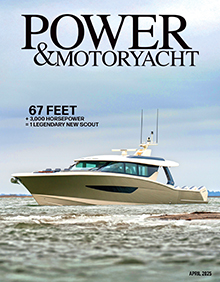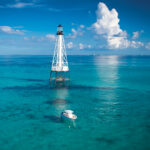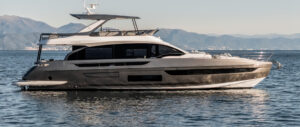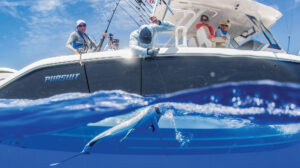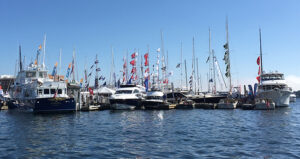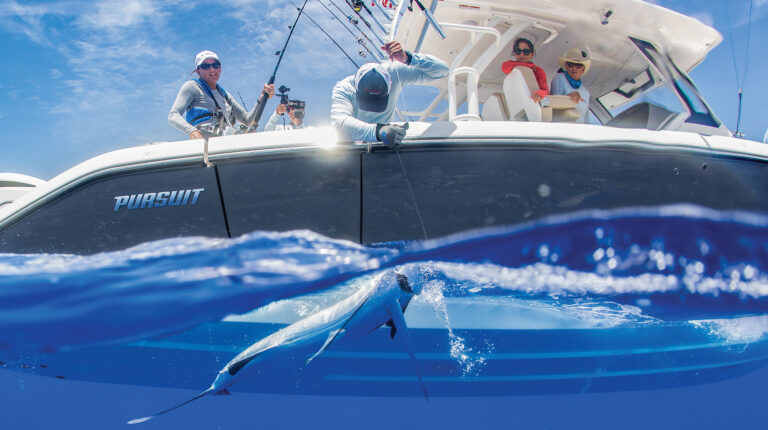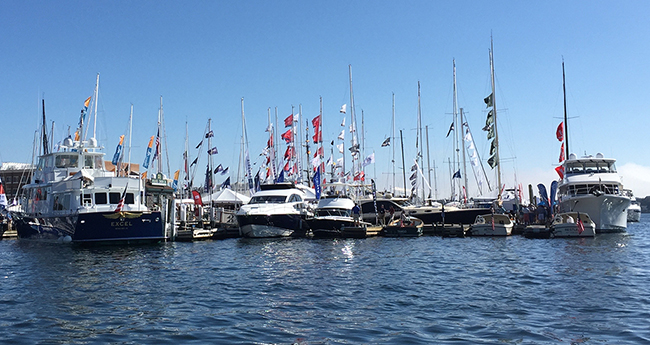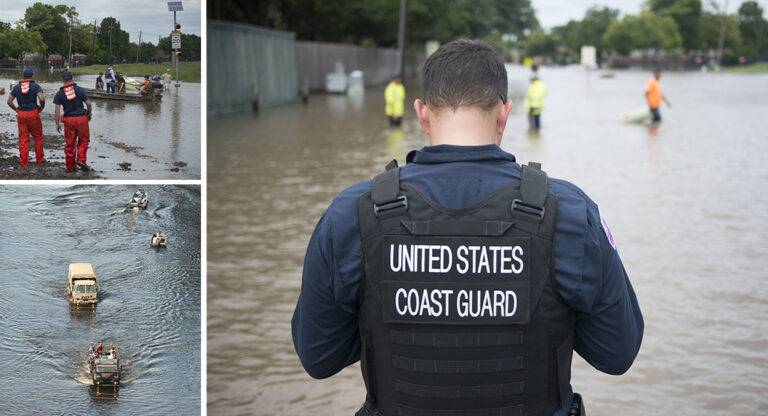
January 2018 — Window on a World
Vineyard Haven, Massachusetts ♦ 41°45’N 70°59’W
Photograph by Beverly Booher

When I was on Martha’s Vineyard it was like a different world to me,” says Ohio-based photographer Beverly Booher. That disparate feeling inspired this shot at the Gannon & Benjamin Marine Railway in Vineyard Haven Harbor on a cool morning. Booher—who is fond of photographing windows “for the mystery behind them”—says the lighting and the juxtaposition of indoor and outdoor spaces are what initially drew her attention. “It was so warm inside and yet you had the feeling of the outside, the water and the coolness.” This is something southerners may never know. As for the rest of us who are cooped up inside and pining for our boats, this shot encapsulates a season ending too soon. It’s a vivid picture we unfortunately know all too well. “It was a different world for me,” says Booher, “and this was a window onto that world.”

November 2017
Obstruction Island, Washington ♦ 48°35’N 122°47’W
Photograph by Coco Aramaki

The poet Elizabeth Bishop once described an island as a “cloud-dump.” What poetic irony that such a cloudy obstruction obstructed -Obstruction Island (try saying that five times fast) when photographer Coco Aramaki snapped this picture of friends spying the landmass aboard the 1968 Grand Banks trawler she had chartered for nine days. A Seattle-based photographer, Aramaki set herself the goal to see all 128 named islands that make up the San Juans, a scattered archipelago in the northwest corner of Washington. While she could have gone the luxury route, with personal chefs and guided tours and daily schedules, she opted for a beautiful old Grand Banks piloted by a salty captain instead. “Growing up on boats, there’s something nice about the camaraderie in working a boat together,” said Aramaki. The natural wonder of the Northwest, which encouraged the crew to cut the engines whenever they saw a bald eagle, was “almost like a call to prayer.” Activities included camping, kayaking, snorkeling, cliff jumping, fly fishing, hiking, and giving fanciful names to the unnamed islands along the way. “It was probably one of the best trips I’ve ever taken in my entire life, and it’s right here in my backyard,” said Aramaki. “I would never have expected that.”

October 2017
Bimini, Bahamas ♦ 25°39’N -79°17’W
Photograph by Charlie Clark

Head due south from Bimini and you’ll see it, a rusted metal shell rising from the reef, like the carrion-picked ribcage of some giant beast. There’s no marker. Nothing to commemorate the watery grave of the SS Sapona. Designed as a cargo ship but used as a casino and lightering barge, she was repurposed for the war effort during World War I by Woodrow Wilson. Wrecked by a hurricane in 1926, she was pressed into service once again, in World War II, this time as -target practice for fighter planes and -bombers on their dive-bombing runs. Between the particularly nasty hurricanes, the bombs and .50-caliber machine gun rounds -unloaded into her hull, it’s amazing that anything is left of this concrete vessel. If a boat could talk, right? Now home to the Bahamas’ vibrant marine life, the Sapona has been repurposed once again, this time as a popular diving and snorkeling destination in Bimini. During the HMY Yachts annual Bimini rendezvous, boaters, some of them first-time owners, descend on the island en masse. Once there, they are encouraged to drop anchor and explore the wreck. Lying in only about 15 feet of crystalline water, it’s a relatively easy dive for beginners. The boldest, thrill-seeking visitors will invariably climb her bomb-ravaged structure and launch themselves some 30 feet into the cerulean seas below. The Sapona might have seen better days but in Bimini her legend lives on.

September 2017
Ten Thousand Islands, Florida ♦ 25°51’N 81°40’W
Photography by Michele Dragonetti

What does the perfect day look like? For photographer Ashley Presley, she found hers on vacation, visiting in-laws in Marco Island, Florida. In this picture, taken on the first day of her trip, friends and relatives are enjoying something special: their own island. (A certain beer’s marketing team would implore you to call it a beach.) The island they found was similar in setting to classic New Yorker cartoons. You know the one: a deserted, sandy, single-palm-tree-occupied, little lump of land where castaways are continually marooned. Said Presley, “It was like a pile of sand and some grass, and water on the other side. That’s it.” In the foreground, family members converge on her family’s Chris-Craft Launch 32, which they were using to ply the waterways. Vast and remote, the cluster of mangrove islets that line the coast occupy a labyrinth of twisting channels that are a favorite of paddleboarders and bird-watchers alike. “We packed up a couple coolers and we were just heading to the southern edge of the [Ten Thousand Islands]” said Presley. From the boat they would hang out, swim, and look for dolphins. Living in Memphis, Presley laments not being able to own a boat of her own, due to being landlocked. But the opportunity to document this trip from a boat was a nice change of pace for the portraiture photographer, illustrator, and painter. And as far as days go, there’s couldn’t have been any nicer. “The clouds in the shot look unreal,” added Presley. “They have that perfect puffiness. It was just a really beautiful day.”

August 2017
Amagansett, New York ♦ 40°58’N 72°7’W
Photography by Michele Dragonetti

Typically, when we imagine boats being at their best, it’s a mental image of a halcyon day: waves splashing playfully against the hull, a yolk-yellow sun warming the decks, an endless expanse of ocean to travel through. (Not unlike many of the photos in this magazine.) What I’m quite sure you don’t imagine: a boat on the hard. Her water-worn blotches and unsightly blemishes hauled up on dry land for all to see. It’s a necessary part of every boat owner’s yearly maintenance plan, but to New York City photographer Michele Dragonetti, it’s so much more. It’s art. “I know and realize there’s a sort of a corrosive, negative impact [going on] on the surface of the boat,” says Dragonetti, “probably the bane of every boat owner’s existence.” A few years ago, wandering Montauk’s marinas, shooting piles of fishing nets and lobster traps, she came across a boat on stands being prepped up for summer. When she went home, she discovered the abstract qualities and triangular shape of the bow came together to form something borderline human: the hidden faces of boats most of us don’t see. Thus started a journey that has taken her to Portugal, Spain, England, and Cuba, and has amounted to thousands of pictures. “Over time I’ve come to think of them as portraits,” says Dragonetti. “They have a consistency in structure just like in human faces, but there’s also a uniqueness in identity just like in human faces showing what each one has been through in their lives.” -micheledragonetti.com
Dragonetti’s photography series Boat Hulls is being -featured at the East Hampton Town Marine Museum in Amagansett, New York, until October 2017.

July 2017
Gulf of Mexico ♦ 28°27’N 88°6’W
Photograph by Austin Coit

The job was not supposed to be an easy one. Shipping out with the Billfish Foundation, photographer Austin Coit -accompanied members of the nonprofit’s tag-and-release program—the largest private billfish-tagging database in the world—to hunt for the elusive predators. Departing from one of the southernmost points of the mangled boot that is Louisiana, the sportfishing crews made a beeline for the offshore oil rigs. With names like Olympus, Bluto, Proteus, and Thunder Hawk, their unintended but very effective function as FADs (Fish Aggregating Devices) for the Gulf of Mexico’s predatory ecosystem make them epicenters for fishing activity. “You see them on the horizon; it’s so crazy,” says Coit. “They look like something out of the movie Transformers or Mad Max. They literally shoot fire out of the top.” Coit, who grew up in Tampa Bay, Florida, had worked as a mate on a sportfishing boat before becoming a full-time photographer. It was on a boat like Sea Mixer, a 64-foot Spencer, where he found his calling. “I got a strange start in photography,” admits Coit. “I had no formal education in it. I did take some documentary production classes in college, but I majored in English.” (On Instagram, Coit titled this shot “The Reveal.”) That may provide a clue to how he works. “Basically with this shot, and others in particular, I don’t just fire away a million photos. I waited for it to happen, and pulled the trigger when it looked like it was about to be right.” Incidentally, the FADs proved their use; the crews ended up tagging more than 11 billfish in three days. austincoit.com

June 2017
Chicago, Illinois ♦ 41°53’N 87°37’W
Photograph by Nick Ulivieri

How do you take shots seemingly above careening stunt pilots during the Chicago Air & Water Show? Easy. You get to the highest vantage point: in this case, the observatory at the top of the John Hancock Center. On a normal day during the summer, but especially during this two-day festival—with skydivers leaving colorful plumes in their earth-bound descents and U.S. Navy Blue Angels booming across the skyline—space along the lakefront becomes a highly prized possession. This places boat owners in a felicitous position, as they drop anchor and watch the drama unfold above North Avenue Beach and Lake Michigan (-August 19-20). Photographer Nick Ulivieri has captured the action for the past eight or so years, shooting from boat, beach, and precipitous heights using a 400-millimeter lens. Of those locations, however, shooting from the observatory might be his favorite place. (His unofficial title there is photo ambassador.) “I don’t see too many airshow photos where the photographer is higher than the aircraft itself,” says Ulivieri. Although he’s quick to add “a boat can provide some really awesome views, too.” He tries to get there around 9 a.m. and stay until the early afternoon, -taking as many pictures in between as he can and only going home to edit. In this shot, Ulivieri captures the Team Oracle stunt plane corkscrewing as onlookers test their maximum passenger capacities. Says Ulivieri, “I kind of like the way the smoke trail winds its way around most of the boats.”

May 2017
Islamorada, Florida ♦ 24°50’N 80°36’W
Photograph by Robert Glover

When you’re shooting from a helicopter you always wonder what you’re going to see,” says Nashville-based marine photographer Robert Glover. In this case—everything. The day this shot was taken was unusual for, among other reasons, a lack of rain for 10 straight days in the Keys in late August; an atypical dry spell for a stormy season. Glover had taken pictures of -Alligator Reef Light dozens of times before, the iron-pile skeleton tower rising defiant above the reef’s shallow coral. But never had he seen the water so clear. He could make out everything moving through the cerulean seas, allowing for an unfettered gaze into the sandy depths. “You could see giant stingrays and sea turtles,” adds Glover. “As soon as we popped up over the [Indian Key Channel] and saw the horizon it was just breathtaking.” A Grady-White Canyon 336 bobbed languidly in the foreground. Glover has been shooting marine photography exclusively for more than 25 years. This is what he lives for. “When stuff all comes together is when it really works,” he says. “In my mind, I had that shot envisioned a certain way, and the second we came out there I was like, ‘Oh, this is exactly what I had envisioned.’ You could go there every day for two years and it may not ever look like that. It’s just lightning in a bottle.”

April 2017
Portovenere, Italy ♦ 44°03’N 9°50’E
Photo by Mark O’Connell

When Mark O’Connell pulled into Portovenere on the custom-built, 177-foot superyacht Maridome, the photographer did what he always does. “I went on a little shoot,” says the Royal Air Force trained photographer. What immediately caught his eye was the picturesque harbor lined with brightly colored buildings; storefronts touting their wares on the water’s edge. In the foreground, tenders bobbed languidly while waiting for their owners to fetch foccacia or a farinata as a snack.
Situated on the Gulf of Poets, Portovenere—named after Venus or a hermit monk, or both—is a springtime magnet for Italians and the international boating community. Among its many charms, it features a rugged promontory protruding into the sea like a huge stone ship, and, of course, the tall colorful buildings. “I love all the colors,” says O’Connell. “Portofino is very similar, but it’s the way they color the whole town like that it’s pretty amazing—I wish more people did it in other cities.”

March 2017
“Pig Beach,” Bahamas ♦ 24°11’N 76°27’W
Photo courtesy of The Bahamas Ministry of Tourism

Oh, how it must be a nightmare working at The Bahamas Ministry of Tourism when even the feral swine look cute, cuddly, and downright inviting with the sun dancing off their speckled pink bodies as they charge headlong into the surf and … swim?
Like a marooned pack of buccaneers on a deserted island in the Exuma Cays, the swimming pigs of Big Major Cay plunder food from passing ships by rewiring any pretense we had about Old MacDonald’s mud-soaked hogs. They frolic on the beach. They dog-paddle in the crystalline waters, aiming their snouts skyward like snorkels. When they reach their target, the pigs hoist themselves aboard, holding their poses like some voluptuous bikini-clad models in Sports Illustrated.
Local legends disagree on the pigs’ origins. Rumor has it that sailors may have dumped them here as a roving meal and never returned for dinner. The unanticipated effect—unless you believe the story that a wise businessman from Staniel Cay planted the porkers—has been a boon in tourism for the island. Whatever the case, word is getting out that these pigs are living the life in paradise. And that’s just fine with them.

February 2017
Havana, Cuba ♦ 23°08’N 82°23’W
Photo by Erin Kenney

I look at Cuba and I see a place apart from time, which is romantic, you know. It appeals to the nostalgic dreamer in all of us. The idea of an island barely a stone’s throw from the mainland that can transport us backwards somehow. A place filled with cars, food, and a people spared from the weight of progress and a globalizing force that runs roughshod over local culture, flattening it like a steamroller.
But of course appearances can be deceiving.
Americans romanticize Cuba with starry-eyed visions such as this: three fishing boats anchored on the western side of the harbor in Old Havana. Sometimes we forget the ones, like the fishermen who are noticeably absent, who stayed and lived in the wake of La Revolución. The hardships they faced in their daily lives are romanticized, too—and as a result their plight is lost, or forgotten.
That may change, depending on the ideology of the new administration in Washington, D.C. But for now, yachts are already bound for Havana and some of Cuba’s other cities, carrying with them American tourists and the promise of a future for this land apart from time. The floodgates have opened.

January 2017
Los Cabos, Mexico ♦ 23°36’N 109°35’W
Photo by Jonathan Cooper

It’s almost jarring at first; the bright white, sugar-sand beach melting into the deep blue of the Sea of Cortez. Behind you are miles of unspoiled mountainous backcountry, before you and just a few miles offshore, is one of the world’s true sportfishing Meccas. This is Costa Palmas, the up-an-coming resort destination from the Four Seasons. Perhaps what makes it most appealing, especially to boaters, is its marina. Already up and running and impressive in its own right, it will be home to 250 slips as well as some superyacht-accommodating water depths. In a world with fewer and fewer destinations left to discover, Costa Palmas will scratch the adventure itch for many yachtsmen who will likely go on to boast, “We were one of the first to be there.” www.costapalmas.com —Daniel Harding Jr.

Do you have a photo that’s worthy of being in Exposure? Send your best shot to [email protected]

